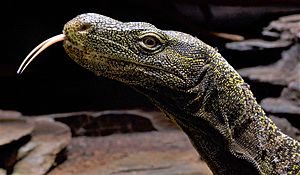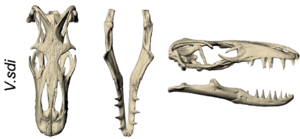Papuan monitor facts for kids
Quick facts for kids Papuan monitor |
|
|---|---|
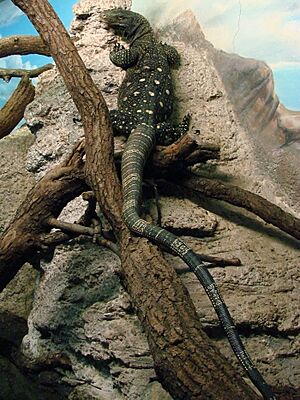 |
|
| Conservation status | |
| Scientific classification | |
| Genus: |
Varanus
|
| Species: |
salvadorii
|
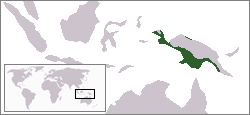 |
|
| Estimated range of V. salvadorii, indicated by green | |
| Synonyms | |
|
|
The crocodile monitor (Varanus salvadorii) is a type of monitor lizard that lives only in New Guinea. It's also called the Papuan monitor or Salvadori's monitor. This amazing lizard is the biggest monitor lizard in New Guinea and one of the longest lizards in the world. Some have been measured at over 2.5 meters (about 8.3 feet) long! Its tail is super long, sometimes even longer than a Komodo dragon's tail, though the crocodile monitor is much lighter.
Crocodile monitors are lizards that live in trees. They have a dark green body with yellow spots in bands. They have a unique blunt snout and a very long tail that can grab onto things. These lizards live in the mangrove swamps and coastal rainforests of southeastern New Guinea. They eat whatever they can find, like birds, small mammals, eggs, other reptiles, and even dead animals. Their big, curved teeth are great for catching fast-moving prey. Like all monitors, they can breathe easily even when running fast, making them very agile.
Sadly, crocodile monitors are threatened by deforestation (losing their forest homes) and poaching (illegal hunting). They are protected by CITES, which helps control their trade. We don't know much about how they reproduce and grow in the wild because they are hard to breed in captivity. In New Guinea, some local tribes hunt these lizards for their skin to make drums. They sometimes see the lizard as an evil spirit that "climbs trees, walks upright, breathes fire, and kills men." But locals also say it warns them if crocodiles are nearby.
Contents
About the Crocodile Monitor
The crocodile monitor, Varanus salvadorii, was first described in 1878 by scientists Wilhelm Peters and Giacomo Doria. They called it Monitor salvadorii at first. Later, in 1885, it was placed in the genus Varanus.
Even though there are no official types (subspecies) of V. salvadorii, people who keep reptiles sometimes talk about them coming from different places like Sorong, Jayapura, and Merauke. These lizards might have slightly different colors on their snout or overall brightness depending on where they come from.
What's in a Name?
The name Varanus comes from the Arabic word waral, which means "lizard." The word "monitor" might have come from a mix-up between waral and the German word warnen, meaning "warning." The name "goanna" is a changed version of "iguana." The specific name, salvadorii, honors Tommaso Salvadori, an Italian bird expert who worked in New Guinea.
Where They Live
The crocodile monitor is the largest of the seven monitor species found on the island of New Guinea. You can find them in both Papua New Guinea and the Indonesian area of West Papua. They live high up in the trees of lowland rainforests and coastal mangrove swamps. Sometimes, during floods in the rainy season, they might leave these areas.
Because their habitat is so remote and hard to reach, we don't have much detailed information about where exactly they live. It's tough for scientists to study them in their natural home.
What They Look Like
A special feature of the crocodile monitor is its blunt, rounded snout. This makes it look different from other monitors in New Guinea and is why it's sometimes called the "tree crocodile." The lizard's body is dark green with yellow spots that form rings. Its tail is banded with yellow and black and is incredibly long.
Their teeth are long, straight, and very sharp. Their claws are also big and strongly curved, perfect for climbing. Male crocodile monitors usually grow much larger than females in both weight and length. Males also tend to have bigger heads.
Like many monitor species, the crocodile monitor can use its body very efficiently for exercise, similar to mammals. They have a special "gular pump" in their throat that helps them breathe. This pump pushes air into their lungs. Most lizards can't breathe well while running, but monitor lizards can. This is because their gular pump helps them breathe even when their running squishes one lung. This special breathing system helps them move quickly. The crocodile monitor is one of the most agile monitors, quickly running up trees and jumping between branches.
Size and Weight
Crocodile monitors are unique because their tail is much longer than their body (from snout to where the tail starts). The tail is usually 2 to 2.7 times longer than their body.
When they hatch, crocodile monitors are about 45 cm (18 inches) long. They become adults when they are around 170 cm (5.6 feet) long. There are many different reports about how long they can get, and it's a bit of a debate. They might be the longest living lizards, but they are much lighter than a Komodo dragon. Some crocodile monitors have been confirmed to reach up to 255 cm (8.3 feet) in length. There are claims of much larger ones, even up to 475 cm (15.6 feet), but these haven't been officially proven.
Reports of their weight also vary. This species is much thinner than Komodo dragons of a similar length. A typical crocodile monitor is less than 200 cm (6.6 feet) long and weighs about 20 kg (44 pounds). However, this weight might be too high for healthy, slender tree-dwelling lizards. Some studies found specimens weighing only 5 to 6.38 kg (11 to 14 pounds) at lengths of 1.16 to 2.25 meters (3.8 to 7.4 feet). A review of healthy adults in captivity found a typical weight of up to 6 kg (13 pounds). Young crocodile monitors caught in one study averaged 99.2 cm (3.25 feet) long and weighed 2.02 kg (4.45 pounds).
Behavior
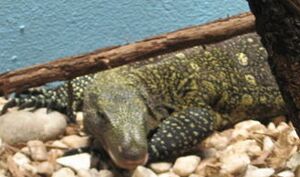
The crocodile monitor spends most of its time in trees. It can hang onto branches using its back legs and sometimes uses its tail to grip. However, the tail's main job is to help balance when the lizard jumps from branch to branch. Like some other monitor species, they can also use their tail to defend themselves. Monitors kept in zoos might try to whip their tails at caretakers. These lizards are sometimes sold as pets, but they are known for being aggressive and unpredictable. Even though they rest and sunbathe in trees, they sleep on the ground or even underwater.
These monitors sometimes stand up on their back legs to look around, just like Gould's monitors. They also have a warning pose where they curl their tails up behind them. Local people believe that these lizards make a warning call if they see crocodiles. Generally, crocodile monitors avoid people, but their bite can cause infection, similar to a Komodo dragon's bite. One person reportedly died from an infection after a bite in 1983.
Their Diet
The teeth of crocodile monitors are different from other monitor species. Most monitors have blunt, peg-like teeth that point slightly backward. But crocodile monitors have long, fang-like upper teeth that stand straight up in their jaw. These teeth are perfect for hooking into fast-moving prey like birds, bats, and rodents. Their lower teeth are covered by a fleshy sheath.
In the wild, crocodile monitors are top predators in New Guinea. They eat birds (like cockatoos), eggs, small mammals (like rats and bandicoots), frogs, other reptiles, and carrion (dead animals). Native people have reported that these lizards can even catch pigs, deer, and hunting dogs, and then drag their prey up into the trees to eat it. Monitors in captivity have been known to eat fish, frogs, rodents, chickens, and dog food.
This species has a unique way of hunting. Instead of just chasing their prey from behind, the crocodile monitor might sneak up on its prey and guess where it will run. Then, it meets the prey head-on.
Reproduction and Life Cycle
Scientists have only seen crocodile monitors reproduce in captivity, so we don't know much about how they do it in the wild. Females lay clutches of four to 12 eggs, usually between October and January. The eggs can be surprisingly different in size, from 7.5 x 3.4 cm (3 x 1.3 inches) to 10 x 4.5 cm (4 x 1.8 inches). Their weight can also vary from 43.3 to 60.8 grams (1.5 to 2.1 ounces). Most egg clutches laid in captivity have not been fertile, and only four successful breedings have been recorded so far.
When they hatch, baby crocodile monitors are about 45 cm (18 inches) long and weigh around 56 grams (2 ounces). Like many other monitors, young crocodile monitors are more colorful than adults. They mostly eat insects and small reptiles.
Conservation Efforts
The crocodile monitor, Varanus salvadorii, is currently protected under CITES Appendix II. This means that if anyone wants to trade them internationally, they need a special permit. It is not listed as a threatened species on the IUCN Red List or the Endangered Species Act.
However, they still face dangers from deforestation (losing their forest homes) and poaching (illegal hunting). Native people hunt and skin them to make drums. As mentioned, some local beliefs describe the monitor as an evil spirit that "climbs trees, walks upright, breathes fire, and kills men." In 2008, there were 52 crocodile monitors living in 17 zoos in the United States, plus an unknown number in private collections.
Images for kids



